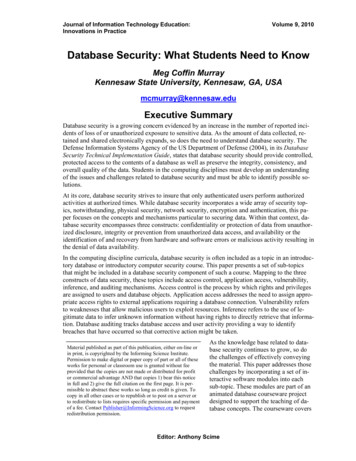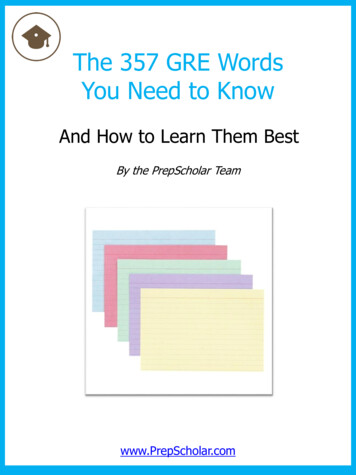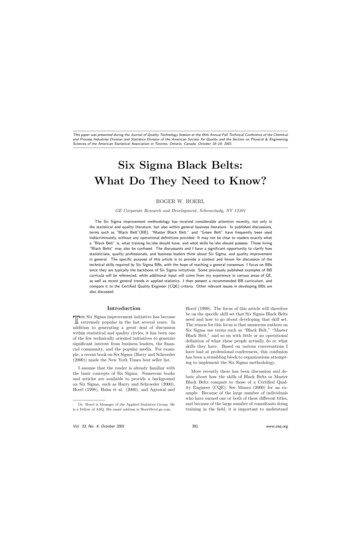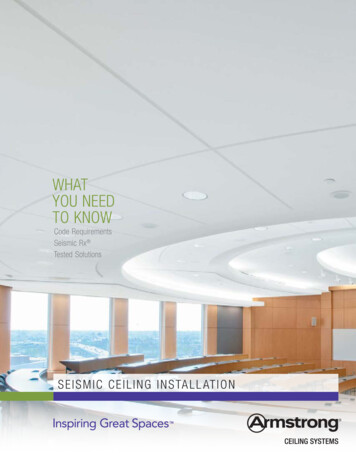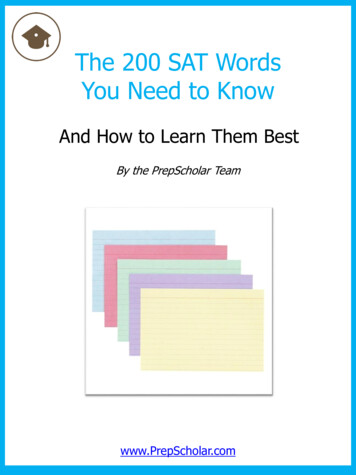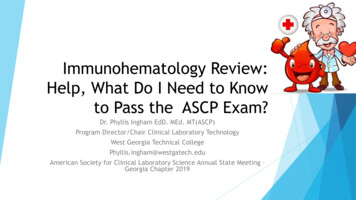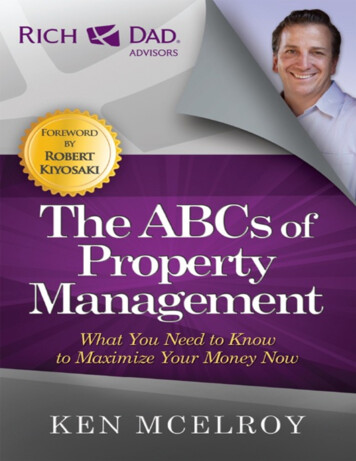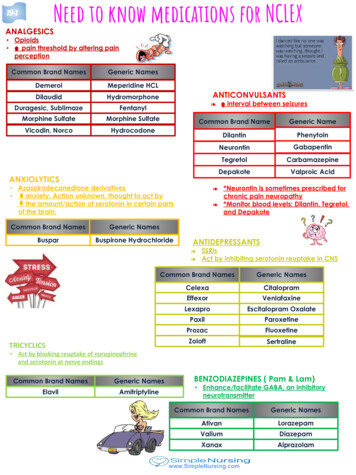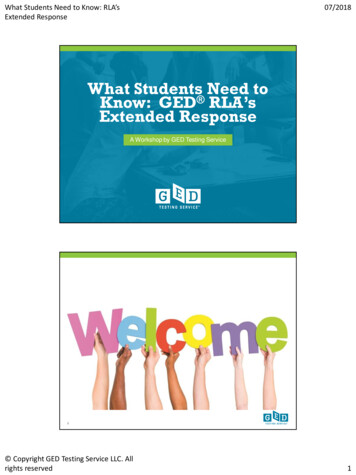
Transcription
What Students Need to Know: RLA’sExtended Response07/2018What Students Need toKnow: GED RLA’sExtended ResponseA Workshop by GED Testing Service2 Copyright GED Testing Service LLC. Allrights reserved1
What Students Need to Know: RLA’sExtended Response07/2018Workshop Objectives Overview the performanceexpectations for CR items andscoring Explore the teaching of keyaspects of the constructedresponse Present a structured approach totackling a writing task Share resources3InquiringMinds Want toKnowRLA Extended Response4 Copyright GED Testing Service LLC. Allrights reserved2
What Students Need to Know: RLA’sExtended Response07/2018Why Constructed Response? CR is the best way of directly assessing Writing skills Higher-order thinking skills RLA ER – 45 min., 20% of test (in terms of rawscore points) And, yes, it is possible to pass without earningscore points . . . however, this is NOT a good teststrategy5The Urban Legends: Instructor Remix Using “I” earns an automatic “0”. The Automated Scoring Engine (ASE) must not beworking properly with all those zeroes “Show us some real student responses . . . Therearen’t any real student responses available to usein the classroom” There isn’t enough time to complete the task Skipping the ER is good test strategy6 Copyright GED Testing Service LLC. Allrights reserved3
What Students Need to Know: RLA’sExtended Response07/2018The Urban Legends: Student Remix NO ONE earns any points on the ER You can game the system by using key words andphrases Forty-five minutes isn’t enough time to read, plan,and write The instructions don’t tell you what you have to do There is definitely a “right” answer—they are just notadmitting it7Constructed Response Items and Scoring Can you pass the RLA test and score a “0” on theER item? Yes, but most test-takers who pass at HSE doget some score points The ER is designed to measure skills at thehigher HSE levels and CCR levels Many test-takers still do not understand the ERtask GEDTS conducted research into how to bestexplain the task and what is required; somemodifications will be made8 Copyright GED Testing Service LLC. Allrights reserved4
What Students Need to Know: RLA’sExtended Response07/2018Constructed Response Items and Scoring How does the computer score the ER item? Whatis it looking for in a response? The automated scoring engine Catalogs the characteristics of a writing sample Compares those characteristics to real exemplarresponses with known scores Assigns a score based on similarity to existingexemplars If no similar responses found, ER is human-scored9Constructed Response Items and Scoring Why should I spend time on teaching writing skillsif students don’t need many points on writing topass the test? Writing skills are one of the criticaldifferentiators of long-term success Building skills in this area helps developthinking skills that impact performance on theentire test Any score point earned counts towards theoverall score10 Copyright GED Testing Service LLC. Allrights reserved5
What Students Need to Know: RLA’sExtended Response07/2018What Is Effective in Tackling the ER? Higher-order thinking skills (critical thinking andreasoning with a dash of problem solving) Effective “close reading” Sufficient understanding of the task to producewriting that is text- and evidence-based Familiarity with the test interface and basickeyboarding skills11Text-Based Writing Requires . . . Proficient reading skills (at a minimum) Organized thinking processes to enableanalyzing and evaluating Ability to recognize and write about evidence A routine (an effective habit) that becomes a“go-to” Sufficient practice12 Copyright GED Testing Service LLC. Allrights reserved6
What Students Need to Know: RLA’sExtended Response07/2018CR Drivers (aka the Three Traits)CR requires . . .1. “Use of Evidence” (Arguments and Use of Evidence)2. “Ways of Expressing Meaning” (Ideas andOrganizational Structure)3. “Language Conventions and Usage” (Grammar &Sentence Structure)to respond to the prompt . . . “In your response, analyze both positions presented todetermine which one is better supported. Use relevant andspecific evidence from the article to support your response.”13RLA ER Requires Students to . . . “Closely” read text that is more complex greater in length Determine what isexplicitly stated Draw specific comparisonsbetween two texts Distinguish between validarguments and faultyreasoning Distinguish betweensupported andunsupported claims Make logical inferencesbased on evidence Draw relevant andsufficient evidence fromthe texts14 Copyright GED Testing Service LLC. Allrights reserved7
What Students Need to Know: RLA’sExtended Response07/2018SharingFindingsTest-Taker Performance: What We’veFound15Why Are Students Struggling? Not utilizing an outline or plan from which to write Not taking a structured approach to the task Not writing enough to be scored (still!) Not fully utilizing the available time (45 minutes)16 Copyright GED Testing Service LLC. Allrights reserved8
What Students Need to Know: RLA’sExtended Response07/2018From Struggling to SuccessfulStruggling WritersSuccessful WritersPlan Are unaware of purpose or process of writing Have little or no knowledge of the textstructure of an essay Have difficulty developing plans and stayingfocused on the topic Experience greater writing anxiety anddecreased motivation Analyze the task Understand and apply all the elements of anessay Create goals for their writing Develop plans to achieve their goals Discuss how and why a plan will workOrganize Produce fewer ideas Fail to organize their thoughts Develop multiple ideas Organize their ideasDraft/write Plan what they are going to say as they write Use imprecise and nonspecific vocabulary Struggle to convey their thoughts, ideas, andopinions Write fewer sentences Focus on mechanics rather than on clarityand organization Write using an organized plan, but adjustgoals when obstacles arise Use vocabulary accurately Experience fewer difficulties with theelements of an essay Generate sentences that support their ideasEdit andRevise Experience problems with grammar,punctuation, and spelling Place words and letters too close or too farfrom each other Do not review and make correction Edit spelling, capitalization, and punctuation Make more content revisions Correct overall appearance17Workbook– p. 2The IRIS Center Vanderbilt Peabody CollegeA Few Insightsto ImproveStudentPerformanceWhat Earns Points18 Copyright GED Testing Service LLC. Allrights reserved9
What Students Need to Know: RLA’sExtended Response07/2018What Earns Points Going beyond merely stating which side is bettersupported A single statement of a stance is consideredinsufficient Needs to include the “why” Doing more than just using quotations Evidence cited must support the overallmessage and must be analyzed in some way19Setting the Claim (statement of stance)This . . .Instead of . . .In the argument for daylightsavings time, the pro daylightsavings position is bettersupported because the researchis more timely and reliable.They say daylight savings timeis a great thing.Between the two positionsarguing whether or not DaylightSaving Time (DST) is useful interms of energy consumptionand safety, the argument infavor of DST is better supportedbecause it uses more factualevidence.The changing to daylight savingtime twice a year is quiteconfusing to a lot of people,especially at the time rightbefore and after the change.20 Copyright GED Testing Service LLC. Allrights reserved10
What Students Need to Know: RLA’sExtended Response07/2018What Earns Points Analyzing the issue or the quality of theargument through which both sides are presented Evidence cited must support overall messageand must be analyzed in some way Demonstrating that the test-taker has engagedwith the text and has created a text-basedargument21Analyze, (Evaluate), and EngageThis . . .Instead of . . .In the argument for daylightsavings time, it seems that the prodaylight savings time position haswon. The first article brings upseveral improvements in the dailylives of Americans which daylightsavings time brings about. Thearticle then uses studies and largescale research to support itsposition. In the second article, onlysmaller scale studies are used,and the writer uses arguments withno factual basis to support antidaylight savings positions.The changing to daylight savingtime twice a year is quite confusingto a lot of people, especially at thetime right before and after thechange. A person can becomeupset when they forget to changetheir clock each time. Moreaccidents can also happen inrushing, when you forget tochange all of your clocks.22 Copyright GED Testing Service LLC. Allrights reserved11
What Students Need to Know: RLA’sExtended Response07/2018What to AvoidResponses should not Be composed of a summary of the passage orauthors’ positions Include personal information (e.g. opinion) Be written in first person (let’s discuss why)ExamplesSummarizationPersonal InformationIf those are the argumentsthat are made, then peoplejust need to be moreresponsible if they arehaving trouble adjusting withthe time change.Back when it was thought ofit made sense – but timeshave changed and now itstime to not have it.24 Copyright GED Testing Service LLC. Allrights reserved12
What Students Need to Know: RLA’sExtended Response07/2018Expectations for Constructed ResponseWhen you write . . . determine which position presented in the passage(s) isbetter supported by evidence from the passage(s) explain why the position you chose is the bettersupported one remember, the better-supported position is notnecessarily the position you agree with defend your assertions with multiple pieces of evidencefrom the passage(s) build your main points thoroughly25Simple Techniques to Improve ScoresExpose students to a structured approach to the writing task andhelp them understand that they need to: Write a complete response (300-500 words), not just a shortparagraph Provide commentary on the evidence cited (explain the “why”) Develop two or three ideas fully, rather than mention a lot ofthings without detail Leave five minutes at the end for proofreading26 Copyright GED Testing Service LLC. Allrights reserved13
What Students Need to Know: RLA’sExtended Response07/2018“Stuff to Teach” Writing about what is read (Hint: Practice, practice, practice!) Using a plan (e.g,. a graphic organizer or an outline) fororganizing the information from the reading and then writingabout it Bringing good grammar to the writing task Answering the question that is asked27A Simple Structure for CRWorkbook– p. 3 The introduction states the main idea or position. It begins with a topicsentence/thesis statement. The beginning restates the question and setsthe stage to answer the prompt.BeginningMiddleEnding Answer the question first. Provide important information the author stated and meant. This is whereyou go to the text(s) and provide examples/evidence and important detailsto support the answer. Sample phrases to introduce each text reference include: stated; in thetext ; for example . . . Include background information as required through the prompt. Write a closing that summarizes the position taken or restates the thesisstatement in a different way.28 Copyright GED Testing Service LLC. Allrights reserved14
What Students Need to Know: RLA’sExtended Response07/2018InstructionalStrategyTeach Analyzing and Evaluating29Interact with Text – AnalyzeWorkbook– p. 4Purpose/ContextWhat is the text about?What type of text is it?What overall purpose does the text serve?AuthorWho is the author of the text?What qualifies him/her to write on this subject?AudienceWhere does the text appear?What does the author expect the reader to do orthink based on the argument/informationpresented?Proof/EvidenceWhat type of evidence is provided? Is more thanone type of evidence provided? Is evidenceprovided for both sides of an argument?Organization/Structure/StyleWhat is the organization of the text? What is thetone? What type of sentence structure/complexity,figurative language, rhetorical questions are used?30 Copyright GED Testing Service LLC. Allrights reserved15
What Students Need to Know: RLA’sExtended Response07/2018Evaluation (makes judgment and explainswhy) Analyzes the purpose of the argument Recognizes the main claim and judges how it isexpressed Understands and evaluates the structure of theargument Evaluates the reliability of evidence Understands and evaluates reasoning about theevidence31Begin with the End in MindPrompt:Analyze the arguments presentedin the press release and the letterto the editor.In your response, develop anargument in which you explain howone position is better supportedthan the other. Incorporate relevantand specific evidence from bothsources to support your argument.Remember, the better-arguedposition is not necessarily theposition with which you agree. Thistask should take approximately 45minutes to complete.Workbook– pp. 5-632 Copyright GED Testing Service LLC. Allrights reserved16
What Students Need to Know: RLA’sExtended Response07/2018Workbook– p. 733Workbook– p. 8Claim“While both sidesmake an acceptablecase, the letterprovides a ress release andletter offerpositions that aresupported by bothfact and opinion”Evidence“a resident is morecredible ascompared to arepresentative”“factual information”“backed by logicalexplanations andfacts with fewspeculations”Counterclaim “press releaseoffers some facts”, but “mainlyspecked with anticipation andhopes” rebutted by theauthor of the letter34 Copyright GED Testing Service LLC. Allrights reserved17
What Students Need to Know: RLA’sExtended Response07/2018EvidenceWhat Drives Argumentative Writing?35Many teachers begin to teach some version ofargument with the writing of a thesis statement[but] in reality, good argument begins with lookingat the data that are likely to become theevidence in an argument and that give rise to athesis statement or major claim.— G. Hillocks (2010)36 Copyright GED Testing Service LLC. Allrights reserved18
What Students Need to Know: RLA’sExtended Response07/2018OtherRecommendationsWhat Drives Argumentative Writing?37Written Argument in the ClassroomThe QuestionYour ClaimYour EvidenceYour Reasoning Evaluate data Make a claim List evidence andreasoning Identify counterclaimsand provide rebuttalsCounterclaims/Rebuttals:Summary of your argument:38 Copyright GED Testing Service LLC. Allrights reserved19
What Students Need to Know: RLA’sExtended Response07/2018Both Sides NowWorkbook– p. 11Students should List the evidence thatsupports List the evidence thatopposes Evaluate the evidence Select the position that isbetter supported Provide reasons why(analysis/evaluation)39Takeaway TipMake YourThinking ProcessesVisible40 Copyright GED Testing Service LLC. Allrights reserved20
What Students Need to Know: RLA’sExtended Response07/2018Help Students Respond More Effectively Review the sample responses in RLA ResourceGuides Closely examine the annotations Help students understand the prompt and what isbeing asked Use the rubrics and/or scoring tools to evaluatestudent work Provide ample practice in class using a variety ofmaterials41Success Begins with Reading Although it may appear counterintuitive, writing successbegins with reading proficiency. Time constraints often result in our going directly toteaching writing without a necessary parallel focus onreading. You CAN teach a proficient reader how to be aproficient writer; trying to teach reluctant readers to bea proficient writers can feel like pushing a boulderuphill.42 Copyright GED Testing Service LLC. Allrights reserved21
What Students Need to Know: RLA’sExtended Response07/2018The Link Between Reading and Writing Reading strategiesStudentswho readReadmore.writebetter.should lead towriting Writing strategiesshould encouragefurther readingStudentswho write43A Final Takeaway Tip:Incorporate reading and writing intoevery classroom, every day44 Copyright GED Testing Service LLC. Allrights reserved22
What Students Need to Know: RLA’sExtended Response07/2018Proficient Readers and Writers Can Read complex text Identify text structure Look for key words and phrases Unpack the prompt Develop a claim or argument Find the evidence that supports that claim or argument Analyze and evaluate the evidence Explain how the evidence is connected to the claim orargument45How to Get Started Have students Closely read source textsand identify the evidence Use the evidence todetermine the bettersupported argument Provide a rationale for whythe argument was bettersupported46 Copyright GED Testing Service LLC. Allrights reserved23
What Students Need to Know: RLA’sExtended Response07/2018ResourcesWhat Drives Argumentative Writing?47Access Online Reading Materials48 Copyright GED Testing Service LLC. Allrights reserved24
What Students Need to Know: RLA’sExtended Response07/2018Access Previous Webinars and Morehttps://ged.com/educators admins/program/4950 Copyright GED Testing Service LLC. Allrights reserved25
What Students Need to Know: RLA’sExtended Response07/2018Thank you!Communicate with GED Testing Service communications@ged.com51 Copyright GED Testing Service LLC. Allrights reserved26
Writing skills Higher-order thinking skills RLA ER –45 min., 20% of test (in terms of raw score points) And, yes, it is possible to pass without earning score points . . . however, this is NOT a g
